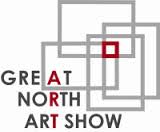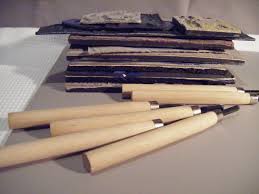The Great North Art Show showcases artworks from a variety of different artists and using a variety of different mediums. The 2014 exhibition includes work by Northern etchers, engravers and printmakers. This is part two of a two-part blog series on these techniques.
Read part one here: Printmaking, etching and engraving: focus on Aquatint and Soft-ground techniques
Etching and engraving are methods of creating repeat patterns, often using a metal plate to create the template.
An alternative method of printing repeat patterns is block printing. There are three main types of block printing: wood block, metal block, and linoleum block.
Linoleum block printing involves carving a design onto a layer of linoleum mounted on wood.
The carved linoleum is then filled with ink and pressed onto paper or fabric to create a print image.
How did linoleum printing come about?
Linoleum was created in the 1800s and used in the late 1800s as a floor covering. Traditional wood and metal block were expensive and time consuming to create.
Linoleum was cheaper to produce, and offered an easier surface to carve than wood and metal, especially when heated. It wasn’t as tough as metal, and didn’t have the surface grains and patterns that made wood trickier to carve. As linoleum was a softer material, it was much quicker to achieve results with the new linocut technique.
According to India Crafts, the word “linoleum” dates to 1863 when Frederick Walton of England combined the Latin word for flax, “linum,” with the Latin word for oil, “oleum,” according to India Crafts.
So linoleum started out as a cheap alternative, and was often used by amateurs or as a teaching product in schools, according to the Printmaking Dictionary.
But when artists such as Henri Matisse and Pablo Picasso started using linoleum in the early 1900s, its popularity grew.
How to do Linocut (linoleum printing)
Cut a design into the surface of the linoleum (lino), using a sharp knife, V-shaped chisel or gouge. Take care to ensure that the raised (uncarved) areas are a reversal (mirror image) of the parts you would like to show as printed.
You should then ink the lino sheet is inked with a roller, and press it onto paper or fabric. The actual printing can be done by hand or with a press.
As the material being carved has no particular direction to its grain and does not tend to split, it is easier to cut, as it lacks the (often) angular and grainy character of woodcuts and engravings. Unfortunately, the fragility of the material means it isn’t suitable for large areas, as the template will degrade much faster than a wood or metal plate or block.
Linocut becomes popular in the UK, Europe and US
Linocuts were popular among the German Expressionist and Russian Constructivist movements in the beginning of the 20th century, including German artist Gerd Arntz, who liked the stark contrasts the technique offered.
The Grosvenor School of Modern Art opened in London in 1925. Claude Flight taught linocut classes there, showing students to produce multi-colour linocut prints by using different blocks for each colour. These British prints were highly influenced by cubism and Futurism. The First Exhibition of British Linocuts was curated by Flight in 1929.
In the 1940s, American artist Walter Anderson began producing large-scale linocut prints at his Gautier, Mississippi home, to be used as wallpaper, hung like scrolls. His work was exhibited in 1949 at the Brooklyn Museum in New York.
Pablo Picasso Linocuts
In the late 1950s, Pablo Picasso advanced linocuts in fine art by developing the reductive printmaking technique. Picasso thought linocuts lent themselves to producing graphic posters and
Picasso’s first prints in the early 1950s were made up of bold and simple images. He liked the linocut technique as he thought it lent itself well to graphic posters, and he began experimenting with creating multiple colour prints using a single block.
His technique involved printing the lightest layer first, with each successive layer being carved away from the linoleum and printed over the last. This reductive technique meant it was impossible to reproduce the work afterwards so artists could create predetermined editions.
Read about two sets of Picasso linocuts recently acquired by The British Museum
Linocut printing in the modern day
The linocut technique of printing has risen and fallen in popularity over the years. With artists like Picasso and Matisse popularising and demonstrating the potential of the technique, its acceptance as a fine art practice was solidified. But as the printmaker and publishers collaborated to produce more complex images, it is practiced much more rarely nowadays.
Great North Art Show 2014: Etchers, Engravers and Printmakers from the North
You can see etchings, engravings and prints from some of the most exciting contemporary artists in the North at this year’s Great North Art Show.
The Great North Arts Show 2014 featured etchers, engravers and printmakers are:
- Michael Atkin
- Laney Birkhead
- Piers Browne
- Hester Cox
- Janis Goodman
- Susie Perring
- Mike Smith
- Ann Tosney
Do you use linocut in your work or do you collect linocut prints?
Has this blog post inspired you to try it out? Do share your learning points for other people experimenting with this technique.
What impact do you think the technique had on the style and popularity of the Expressionist and Russian Constructivist movements? Is it more or less relevant today?
Which modern linocut print artists do you like best and why?
Do share your thoughts in the comments box below – we’d love to hear what you think!



